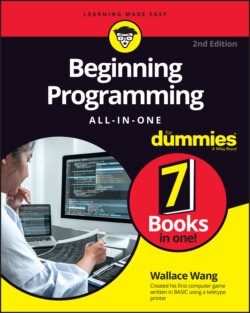Читать книгу Beginning Programming All-in-One For Dummies - Wallace Wang - Страница 18
Using assembly language as a shortcut to machine language
ОглавлениеThe whole purpose of assembly language is to make programming easier than machine language. Basically, one assembly language command can replace a dozen or more machine language commands. So, instead of requiring you to write ten machine language commands (and risk making a mistake in all ten of those commands), assembly language lets you write one command that does the work of ten (or more) machine language commands.
Not only does this reduce the chance of mistakes, but it also makes writing a program in assembly language much faster and easier. Best of all, assembly language commands represent simple mnemonics such as MOV (move) or JMP (jump). These mnemonic commands make assembly language much easier to understand than a string of binary commands (1s and 0s).
The goal of every programming language is to make programming simpler and easier. Unfortunately, because no one can define exactly what simpler and easier really mean, computer scientists keep creating new and improved programming languages that promise to make programming simpler and easier, at least until someone else invents another new and improved programming language.
To understand how assembly language works, you must first understand how processors store and manipulate data. The processor is the “brain” of the computer that does all the work. By itself, the processor is fairly useless.
Think of Einstein's brain floating in a jar of formaldehyde. It may be one of the smartest brains in the world, but if it can’t communicate with the outside world, it’s completely useless as anything other than a very unusual paperweight. Like Einstein’s brain in a jar, your computer’s processor is useful only if it can communicate with the outside world. The processor communicates with the other parts of the computer through a series of wires called a bus.
When a processor needs to work with data, it retrieves it from another part of the computer (such as the hard disk or memory) and temporarily stores that data in a storage area called a register, as shown in Figure 1-1.
FIGURE 1-1: A processor uses its registers to temporarily store data.
The processor then edits the data in its registers and sends the changed data back to another part of the computer, such as the memory or hard disk.
So, computer programming progressed from physically rearranging wires and switches (with ENIAC), to flipping switches using 1s and 0s (with machine language), to telling the computer which data to store in which registers and how to manipulate that data (with assembly language).
A typical assembly language command might look like this:
mov al, 061h
This command tells the processor to move (mov) the hexadecimal number 061h into the specific register named al. Other assembly language commands might tell the processor to add (add) or subtract (sub) a value from the number stored in a specific register.
When you use assembly language, you have to tell the processor what data to store in which registers, how to manipulate the data in the registers, and when to remove data out of the registers.
Sound tedious? It is. Although assembly language is far easier to understand and write than machine language, it's still too complicated to use for creating really big computer programs, like word processors or video games.
In the old days, most programs were written in assembly language, but as programs grew larger and more complicated, assembly language proved too cumbersome to write, edit, and modify.
The biggest problem with assembly language is that you need to manipulate the processor’s registers just to do the simplest tasks. If you wanted to add two numbers together, you’d have to tell the processor to store a number in a register, add a second number to the number in the register, and then yank the result out of the register.
Forcing people to know how to manipulate the processor’s registers before they can program a computer is like forcing people to know how their carburetor works before they can drive a car. Ideally, you don’t want to tell the processor how to manipulate data in its registers; you just want the processor to add two numbers without worrying about specific registers. So, to make computer programming even easier, computer scientists have hidden the technical details of manipulating registers by creating high-level languages.
Every processor understands only its own particular assembly language. So an Intel processor won’t understand the assembly language of an Advanced RISC Machine (ARM) processor and vice versa. However, some companies make processors that work identically to other processors. For example, a company called Advanced Micro Devices (AMD) makes processors that work just like Intel processors, so an assembly language program written for an Intel processor also works on an AMD processor.
